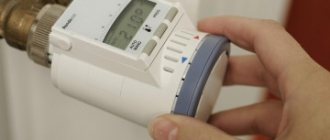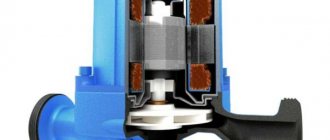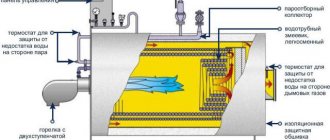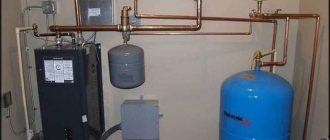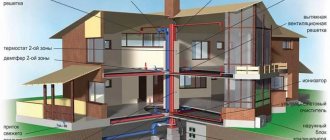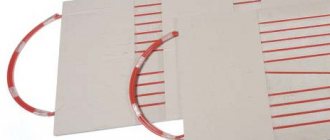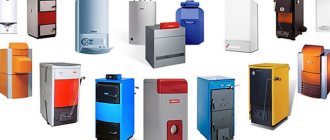Recently, heating meters have been in particular demand, as they can reduce heating bills by almost half. Let's find out what is the reason for the demand and whether heat meters help you save money, what types of devices there are, and on what principle they work. We’ll figure out how to install the devices correctly and whether it’s possible to do it yourself, where to get permission and how to take readings correctly.
Individual counter Source cstor.nn2.ru
Saves or not
Every year housing and communal services become more and more expensive, a considerable part of which goes to paying for heating. When calculating the amount, it is often overestimated, using not individual data from each house, but approximate, theoretical ones. In order not to overpay for heat that was not used to heat their home, many install a heating meter.
It is important to immediately note that the thermal energy meter does not save heat itself. It only calculates exactly how much energy was spent on heating. However, in this case, the owner will have to pay not for average indicators, which often include losses from the passage of water through pipes and possible flaws in the network itself, but for the amount of heat actually spent. Thanks to this, costs are reduced.
The meter will allow you to clearly see how much money is spent on heating a particular room. If the temperature is lower than what the service provider agreed to provide under the contract, the latter must return the money paid.
In addition, thanks to the meter and control, homeowners may decide to insulate the premises in order to pay less, for example, by changing windows.
Meter in a private house Source eno-tek.ru
Monthly payments for someone else's living space
Each apartment building must be equipped with a heat meter - Article 13, paragraph 5 of Federal Law No. 261-FZ of November 23, 2009 .
The management company fulfills this condition and, based on the results of each month, records the heat consumption for the high-rise building under its management.
The amount for thermal energy is simply divided between apartments according to their living space. Although this approach cannot be fair.
Good money is spent on heating bills. And half of them are wasted
The data on living space available in the Criminal Code are based on the technical passport of each apartment. However, such technical data sheets often do not take into account data on apartment redevelopments that increase the heating area.
It does not contain information about increasing connection points for heating radiators.
Meanwhile, apartments with redevelopment and an expanded number of heating devices consume more heat than others.
And since the general building consumption of thermal energy is divided according to the registered living space, residents of “ordinary” apartments pay for the heat consumed by residents of “improved” apartments.
Individual heat meter on the horizontal heating circuit of the apartment
A simple way out of the situation with paying for someone else’s heat is individual meters on the heating circuits of apartments.
Cost savings on thermal energy, the consumption of which is determined by a heat meter, will amount to over 30% of previous heating payments tied to the size of the living space (standard).
Design Features
A heat meter is a set of several devices: a temperature sensor, a water quantity meter and a computer. Depending on the type and model, the designs and operating principles vary.
According to their purpose, heat meters are:
- Individual or apartment. Installed in private houses and apartments with central heating.
- Industrial. Used in industrial and commercial facilities, offices.
- Common houses. Mounted in separate blocks or entrances.
The meters also differ in throughput volumes, pipe diameters and sizes.
It is convenient to install a common house appliance on the common pipe of a separate entrance, dividing its cost among all residents. The monthly payment is also shared by everyone. Common house devices are much more expensive than individual ones, but when dividing, everyone will have to pay a little. However, if the neighbors do not agree to this, it will not be possible to install a meter.
This is due to the fact that a separate permit must be obtained for the installation of each heat meter. In some houses, especially older ones, it is not easy to obtain permission.
An individual meter is installed on the supply or return pipeline Source siteapi.org
There are several types of heat meters. Each of them has its pros and cons.
Mechanical
Mechanical heat meters for heating are the simplest and cheapest, which explains their popularity. The average cost is 8-10 thousand rubles. The principle of operation of a mechanical meter is simple: inside the device, as water passes, a special device rotates, which determines how much coolant has passed. Tonometers are installed on the supply and return pipes to measure temperature.
Depending on which part rotates inside, mechanical meters are divided into screw, vane, and turbine.
The advantages of the devices include:
- Low price and quick payback. This is the most inexpensive and accessible device of all.
- Simplicity and reliability. It is easy to install yourself and can be connected in any position.
- No electrical connection required.
- It transmits indicators stably and does not depend on external circumstances.
Mechanical meter Source kalorimetre.com.tr
Disadvantages include short service life. A mechanical heat meter is designed to last approximately 4-5 years, after which rust and impurities usually cause it to fail. To extend service life and make readings more accurate, it is recommended to install a water filter.
See also: Catalog of companies that specialize in engineering systems and related work
Ultrasonic
The operating principle is associated with ultrasonic vibrations that travel along and against the flow of water. The heat meter for the battery consists of two parts, which are installed opposite each other at some distance. The emitter emits ultrasonic waves, the receiver receives them. The travel time depends on the speed of the water. Heat consumption is calculated depending on the time spent.
Models can be time, frequency, correlation, Doppler.
The advantages of an ultrasonic meter include:
- High data accuracy.
- Durability and reliability.
- On some models you can configure individual water supply.
Ultrasonic heat meter Source prom.st
The disadvantages include high sensitivity to water purity. Even with minor contamination, readings may be inaccurate. It is recommended to install the ultrasonic device together with the filter. Also, most devices run on batteries that need to be recharged on time.
Electromagnetic
Used to count large volumes of water: in a whole entrance, office, commercial premises, etc. The operating principle is based on changes in electromagnetic pulses: water passes through a magnetic field, a current appears, the readings of which are read by the device.
Electromagnetic meter Source kepchel.ru
The electromagnetic battery meter is characterized by its small size, accurate readings and reliability. It is easy to install on large diameter pipes and easily copes with water flows.
Like other heat meters, electromagnetic models do not work well with large amounts of impurities in the water, especially iron. In addition, the devices are sensitive to nearby operating electrical equipment (readings may be inaccurate) and often operate on mains power.
Vortex
The meter consists of a vertical triangular prism, a magnet on the outside and an electrode that monitors the flow pressure.
The operating principle is based on the appearance of vortices. The latter are formed when water bends around an obstacle in its path. The vortices form a constant path, a stalled flow of pulsations around the water, from which the device reads the volume of moisture.
The main advantage of a vortex counter is that it can be used even with contaminated water, with impurities or with trapped air. However, large contaminations can damage it. Can be mounted on horizontal and vertical pipes of any length.
Why is it necessary to install a heating meter in a residential area?
The lack of high-quality heating due to improper operation of the heating network often forces apartment residents to look for alternative heat sources. At the same time, the cause of poor heating is not always a breakdown in the heating network. Often, housing and communal services workers, in an effort to save money, tighten the valve, which reduces the flow of hot water, which is especially felt by residents of the upper floors of high-rise buildings.
Quite often, due to poor performance of the heating network, it is necessary to look for alternative heat sources
This results in insufficiently warm batteries and the need to use electric heating devices, which, in turn, entails increased energy costs. Heating in an apartment does not become cheaper. The result is that users have to overpay on all fronts.
Important! An installed and registered heat meter for the battery will allow you to pay only for the heat consumed by a particular apartment, and for nothing more.
Another reason for high payments is often the difference in the temperature of the water that comes out of the boiler room and the one that goes directly into the apartment. Often, the temperature of the water in the radiator is significantly lower than normal, which occurs due to heat loss on the main line due to poor insulation or damaged pipes. Even in this situation, all costs fall on the shoulders of the end consumer.
Sometimes the situation can be completely different when the radiators are so hot that you have to open the windows to ventilate the room. In this case, you have to pay, in fact, for heating the street, which is also not considered correct. Regulators, which are often installed together with heat meters for heating, will help you avoid problems.
Scheme of operation of a heating meter in an apartment
The main advantages of installing a heat meter in an apartment
The heat energy meter is mounted directly on the pipe through which heating enters the apartment, and calculates only the amount of heat actually used. If you additionally install a thermostat to the device that controls the flow of water, you will be able to control the flow of hot water, which can be reduced if necessary. As a result of the work done, the final consumption figure will be significantly lower than that determined by the standards.
After installing and registering a heat meter in an apartment, you can be sure that only the costs of heating the home will be taken into account in the payment. You will not have to pay for heat losses during transportation or associated costs resulting from poor-quality services provided by the heat generating company after installation. Heat metering is carried out based on the following indicators:
- consumption of hot water delivered to the apartment;
- water temperature at the entrance to the heating system and at the exit from the apartment.
As a result of expenses, the amount of heat consumption per day, month or year, calculated in hectacalories, is determined. Modern apartment heat meters have the ability to store data on monthly heat consumption for a long period, usually up to 10 years. Some devices have an additional option that allows you to connect it to a computer and transmit readings via the Internet.
The main advantage of the meter is the ability to significantly save money
If there is any doubt whether a heating meter in an apartment is profitable, you can pay attention to a simple calculation: the price of the device together with installation is from 7 thousand rubles, and the minimum service life is 12 years. Over the course of one season, you can save from 4 thousand rubles on heating using a meter, which depends on the area of the apartment. Accordingly, over 12 years of use, at least 48 thousand rubles are saved, and this figure is far from final.
Helpful information! The only option when you should think about whether it is necessary and possible to install a heating meter in an apartment is if the housing has a vertical connection system and has not one riser, but several. In this situation, each riser needs its own meter, and this is already expensive. In such a situation, it is recommended to install one device per entrance.
The costs of operating the meter are insignificant, because basically you only pay for calling a specialist to check the device, which is carried out no more than once every 5 years. It is also sometimes necessary to replace the batteries, but this also has to be done by those who do not use the meter.
Measurement accuracy
Like any device, a heat meter has a certain error, which consists of the errors of individual elements. In a residential area, the general error is 6-10%, but actual figures may vary.
The error may increase if:
- The difference between the inlet and outlet temperatures is less than 3 degrees.
- Errors were made when installing the meter. It is important to remember that if the installation was carried out by an unlicensed company, the manufacturer will not cover it under warranty.
- There are impurities in the water, including mechanical ones, or it is too hard, the pipes are old and rusty.
- The water flow is weaker than specified in the technical specifications.
Installation of a heat meter Source eno-tek.ru
In the USSR, the amount of heat was calculated in gigacalories (Gcal), in Europe - in gigaJoules (Gj). The international unit of measurement is kWh. When taking data, you can convert data from one measurement system to another by multiplying by a coefficient.
Main types of heating system wiring in a residential building
Multi-storey buildings can have one of the heating system layout options - vertical or horizontal. Old buildings, such as Khrushchev and Stalin buildings, are mainly characterized by a vertical heating system. In this case, the heating network circuit can be one- or two-pipe. However, the flow of coolants through interfloor levels has a sequence from bottom to top and top to bottom. The main disadvantages of vertical wiring:
The heating distribution system in a multi-storey building can be vertical or horizontal
- The heat is distributed unevenly, because the coolant is driven along the interfloor circuit with a vertical orientation. As a result, apartments on different floors will receive unequal amounts of heat. Thus, apartments in a 10-story building up to the 5th floor will be heated better than the last 5 floors.
- The complex process of regulating the flow of heating into the radiators and the need to install on each battery an additional jumper in the form of a pipe, the so-called bypass, which regulates the flow of coolant in the radiator.
- Constant reconfiguration of shut-off valves depending on changes in pressure and temperature of the water supplied to the system.
The main disadvantage of vertical wiring is the difficulty of installing an individual heating meter in an apartment, because you will need to purchase a separate heat meter for each riser, which significantly increases costs. In this case, another tool for measuring energy consumption is more often used - a heat distributor, the installation of which will require the consent of at least 50% of the residents of the entrance.
Most new buildings are distinguished by horizontal heating distribution, when there is also a vertical riser designed to distribute the coolant to different floors, and a return line. From both the first and second risers, horizontal pipes are installed into each apartment, carrying out both the supply and return outflow of water from the system. The return line serves to collect cooled water and transport it back to the heating station. The advantages of horizontal wiring include:
- the ability to regulate the temperature of the heat supply to the radiators of each apartment;
- carrying out system repair work in a separate circuit without disconnecting other apartments;
- the ability to disconnect each circuit separately from the heating.
Diagram of a horizontal heating system in an apartment building
Transfer of readings
An individual heat meter only records the amount spent. After its installation, the owner will have to record and send data on energy consumed every month. To do this, you will need to record the readings for the current month, then subtract the data from the previous month from them.
To figure out how to take readings from a specific device, you need to study its technical data sheet. There are several ways to do this:
- Devices with a liquid crystal display display readings on the screen, from where they need to be written off.
- Many European models have an ORTO transmitter, which transfers all information to the computer.
- Meters with an M-Bus model are included in the central data collection network. Several devices are connected to each other with a low-current cable and then connected to a hub. The latter regularly sends requests to all heat meters and receives data from them, which is transmitted to the heat supply organization or to a computer.
Meter with display Source deacademic.com
- Some heat metering devices are equipped with a radio module. This allows data to be transmitted wirelessly over distances of several hundred meters. As soon as the receiver is in range, the radio module records the data and transmits it to the heat supply company. Some companies attach a receiver to the garbage truck so that it can regularly collect information along the route.
All data on consumption, downtime, temperatures and errors is stored in the archives of the devices (for some, directly on computers). During installation, you can configure a convenient archiving option - every hour, day, month or year.
If consumption information is not automatically recorded by the heat supply company, it must be sent independently. To do this, you need to create a personal account on the company’s website and regularly enter data.
The best heat meters according to consumer reviews
We bring to your attention the most popular models of heat meters:
- Elf DN 20 mm. Tachometer heat meter made in Poland. Designed for low thermal power (up to 85 kW). Capable of remotely reading readings from automation. Absolutely resistant to magnetic influences, has wide communication capabilities.
- Sensonic II DN20. A reliable compact device with high accuracy in measuring indicators of the consumed type, having an acceptable cost.
- SensoStar 2 Engelmann. The German-made model, represented by a design of exceptionally high-quality assembly, very accurately determines the amount of heat consumed by magnetic-free scanning of the impeller.
- KARAT-Compact-201. Easy to maintain, compact, low cost and modern design. The unique technology for creating device parts makes them wear-resistant and corrosion-resistant.
As you can see, choosing the optimal heat meter model is a fairly simple process. The main thing in this matter is a clear understanding of your needs, the desire and ability to spend a certain amount of money and follow the advice presented above. Happy shopping!
Video description
How profitable it is to install heat meters using the example of Penza residents is discussed in the following video:
The second condition is that a common house heat meter must be installed at the entrance.
Before installation, it is recommended to eliminate heat loss yourself, for example, insulate corners or replace windows.
Installation takes place in several steps:
- A written application is submitted to the Criminal Code with a request for permission to install the device. A copy of documents confirming the ownership of housing and a registration certificate are attached to it. The management company must provide technical specifications that indicate all the requirements for the device and information about the heating network. If it is impossible to install a meter in the house, the management company will tell you about it right away.
- An installation project is being developed. To do this, you need to contact a specialized design company. The project indicates the type and model of the meter, makes calculations on the thermal load, possible heat losses and water consumption, and also attaches a diagram of the heating system with a note where the meter is planned to be installed.
Installation of a heat meter Source bel-teploenergo.ru
- Next, you buy a heat meter for heating. It must meet all the parameters calculated in the project and have a quality certificate.
- A design solution for installing a meter is ordered from a design company. This can only be done by a company that has the appropriate license.
- Only specialists with the appropriate license and experience can perform installation.
- Finally, an employee of the management company must seal the device and sign the work acceptance certificate.
If desired, the owner can simply contact a company specializing in the installation of heat meters and transfer all matters to them. This will cost much more than collecting documents yourself and contacting an organization, but it will save effort and time.
Checking the meter Source dvina29.ru
Subsequently, the heat meter for the heating radiator is checked every four years at the expense of the residents. To do this, you need to contact Rostest, the manufacturer’s service center or a company that has permission to conduct the test.
Installation and connection steps
To install and connect a metering device, you need to go through a number of procedures, and most importantly, select the meter itself.
Procedure steps:
- To begin with, an installation diagram is drawn and the optimal device model for a specific wiring is determined.
- A contract for the supply of resources is concluded. Currently - with a heating company.
- Then follows the receipt of technical conditions for connection.
- An organization is selected that will carry out installation work with warranty service during operation.
- After completion of the installation work, an act is signed between representatives of the resource company and the owner. It indicates the date the meters were put into operation with initial readings and verification intervals.
Installation requirements
Installation work must be carried out by a company that has all the permits for the right to engage in this type of activity.
To avoid making a mistake with your choice, you need to check:
- fact of company registration;
- availability of permitting documentation (the right to engage in a type of activity);
- qualifications of specialists;
- provision of materials and equipment;
- availability of services for drawing up calculations and measurements;
- the possibility of concluding a long-term cooperation agreement with warranty obligations.
Briefly about the main thing
Heating meters are devices that record exactly how much heat was spent heating the house. Thanks to them, you don't have to overpay.
They differ in size, purpose (for an apartment, a house, an entrance, an office, etc.) and design features. Each model has pros and cons.
Not all premises can have a heat meter installed. Before purchasing and installation, you must obtain consent from the management company.
Design, installation and subsequent inspection can only be carried out by specialists with appropriate licenses. Self-installation is prohibited, data will not be accepted.
Apartment heat meters per battery: what are they?
There are 4 types of residential heat meters per battery:
Tachometer heat meter for battery
- Tachometer (more often called simply mechanical)
- Ultrasonic
- Electromagnetic
- Vortex
The cheapest ones are tachometer ones. The average price of a heat meter per battery is 10 thousand rubles. Service life – no more than 4-5 years. Installation cost – at least 4 thousand rubles.
Ultrasonic heat meter for battery
Ultrasonic ones are more expensive, but not much. They provide greater accuracy of indicators and are not afraid of hard water.
Electromagnetic and vortex generators are expensive; they are bought mainly by industrial enterprises and large organizations.
It should be taken into account that if you have a vertical distribution of the heating main (that is, each battery has its own riser), then you will have to install a heat meter on each drain. For a three-room apartment - 4 pieces (counting the kitchen radiator). Total – 56 thousand rubles. This kind of money will not pay for itself over the service life of the meter.
Electromagnetic heat meter
Vertical wiring is used in old houses. Mostly Soviet-built. More modern residential buildings use horizontal wiring. This is when one supply pipe enters the apartment, on which all the batteries are “placed”, and then the used water comes out through the outlet pipe. In this case, the meter can pay off.
Installing a heat meter on a battery itself is not a simple matter. But the design of this event is no simpler. Necessary:
- Submit an application to the housing office and obtain permission to install a meter
- Draw up a meter installation project
- Approve the project in the Housing Office
- Install the meter
- Invite a housing office representative to seal the meter
And this is every 5 years!
Installation of a heat meter on a battery
Of course, if you order the installation of a meter from a contractor, they will perform the approval and permitting procedures for you. And another option is officially impossible: only certified organizations with the appropriate licenses can install residential heat meters on a radiator. No DIY!
What to do if the heating radiator is leaking? You will also find a solution to this problem on our website.

